
A very common disease of small cichlids and sometimes other types of fish is the appearance of small white spots, like fluffy pimples, on both sides of the fish’s head. This is called “canal neuromast inflammation” or “CNI”. This also manifests as a big “scrape” on the forehead, like an open sore on the forehead of the fish. This type of canal neuromast inflammation can come on very rapidly and then disappear very rapidly. It is NOT an injury. The fish hasn’t “bumped its head”.
Easily 80% of the time this is caused by dirty water with a high bacterial count. It is usually best cured by adding a whole lot of good filtration. Hang on back filters and in tank cartridge filters do not give good filtration.
The rest of this is a rather long boring dissertation on this syndrome. It’s only for real nerds like the author.

Canal Neuromast Inflammation Syndrome in Depth
There are sensory cells on a fish which allow it to sense what is going on around them. One type of these cells are called the “canal neuromasts”. These canal neuromasts are located as shown below.
.

.
Note how the location of the white eruptions on these smaller cichlids exactly follows the location of the canal neuromasts:
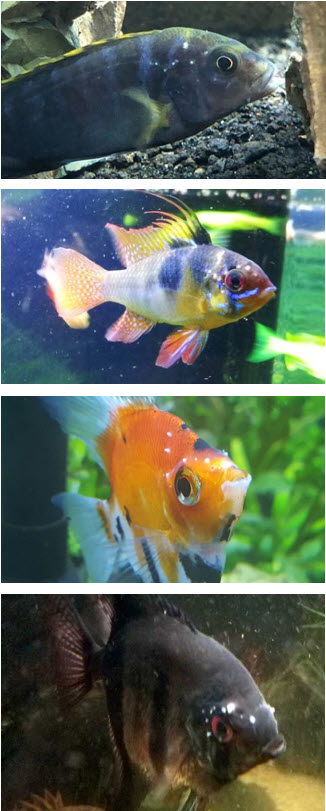
In canal neuromast inflammation bacteria and water toxins are attacking the tissue in small spots along the canal neuromasts and the fish’s immune system is responding with a white pus which presents as white tufts. The white tufts are about 3 times the size of an ich organism and have a fuzzy white look to them which can move with the current. These blobs will fall off regularly and be replaced with new ones (like “scabs”).
The white tufts are almost always in identical patterns on both sides of the head. This will not happen with any other disease. There are several hobbyists on several blogs who have had this disease progress for several months. After several months the white tufts become the typical pits and ulcers of hole-in-the-head (HITH) syndrome. This hill stream loach shows that cichlids are not the only fish that get this. ANY fish can get it.

There was also one keeper of Malawi cichlids which had a fish with a line of white tufts down the lateral line neuromasts rather than on the head where the canal neuromasts are. This would be treated the same as erosion of the head canal neuromasts.
Now some might say this isn’t canal neuromast disease but is simply hole-in-the-head in small cichlids. To me that’s just a terminology issue. It’s some sort of infection or breakdown of the canal neuromasts. To better understand the relationship between the white spots on the head of the smaller cichlids and the HITH lesions on a large cichlid, another photo is in order.
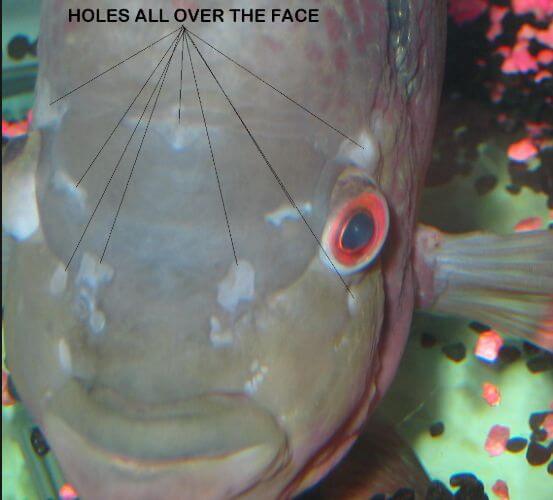
This is classic hole-in-the-head in a large cichlid. Note the bi-symmetry of these holes. These HITH lesions correspond exactly with the locations of the neuromasts on a fish’s head as shown in this diagram:
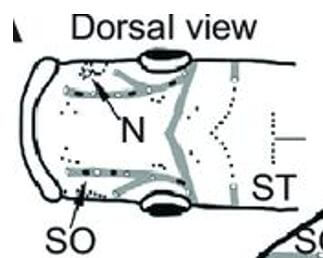
The white spots on a small cichlid and the holes on the large cichlid are obviously at least diseases of the same organs, if not the same disease.
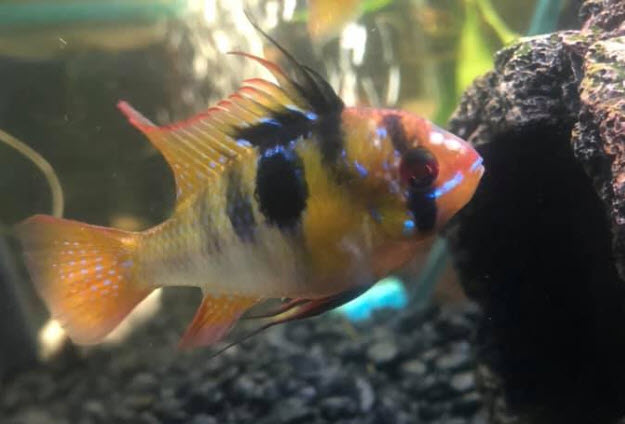
Causes of Canal Neuromast Inflammation
Fish with canal neuromast inflammation typically have some combination of the following problems:
- 80% have unclean water with high bacterial counts,
- 70% are being filtered with only hang-on-back filters or sponge filters.
- 30% have hexamita (“internal parasites”)
- 30% have mycobacteriosis (“Fish TB”)
- 10% are starved
- 100% have secondary bacterial infections in the lesions
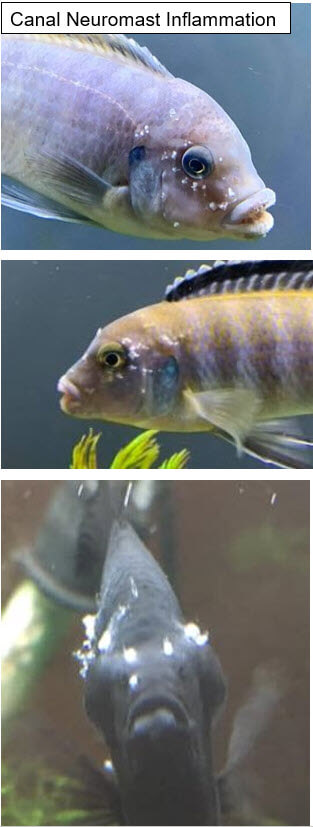
Treating Canal Neuromast Syndrome
To treat canal neuromast inflammation, one needs a multi-pronged attack:
- High bacterial counts are found in the water of most fish with canal neuromast inflammation. High bacterial counts compromise the immune system of the fish. Add much more biofiltration (canister, under-gravel or sump) with a good media like foam pot scrubbers or static K1 media. It also helps to add a UV sterilizer.
.
This is the single most important thing to do if one has canal neuromast inflammation. It’s importance cannot be over-emphasized!
.
-
- Remember the cardinal rule of filtration for healthy fish:
.
One Pound of Fish Needs 100 Square feet Of Biomedia Surface Area
.
-
- This amount of biomedia give good water clarity and good fish health. Note that ammonia and nitrite oxidation only require 5 square feet of biomedia surface area. Many people come on social media saying “my fish are all slowly dying from something with no symptoms but I have zero ammonia and zero nitrite so my filtration is good. What gives?” “What gives” is that healthy fish need twenty times the surface area of biomedia than what is needed for ammonia oxidation. This fact is missed by all on social media.
- Hang-on-back or sponge filters which have inadequate biofiltration capabilities will give “dull”, cloudy, bacteria filled water which contributes to hole-in-the head through several means. Add much more biofiltration. Under-gravel filters do a great job of biofiltration if they are never cleaned. They do a very poor job of biofiltration if they are cleaned often. Sponge filters can give decent biofiltration if they have a powerhead added to the lift tube. And canisters are always much better than hang-on-back filters.
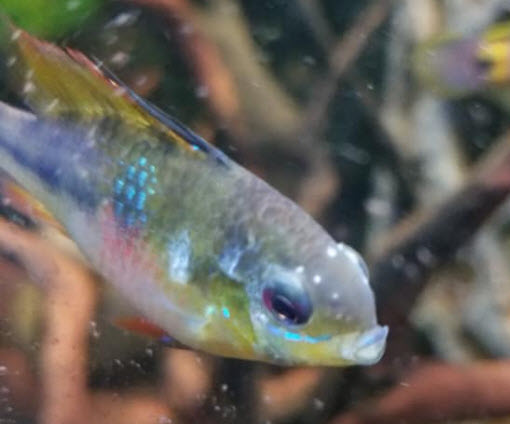
- Necropsies done on fish that have died of canal neuromast inflammation show the following conditions:
- Many canal neuromast inflammation fish have fish TB (mycobacteriosis) in granulomas in their organs. Add much more biofiltration and/or a UV sterilizer to the aquarium.
- Many canal neuromast inflammation fish have hexamita (spironucleus) organisms in large numbers in the gut and sometimes in other organs in the body. Treat with metronidazole medication in the food and only in the food
- Hexamita is often associated with a lack of vegetable fiber in the diet Add fiber or chitin to the diet
- Many canal neuromast inflammation fish have organs infected with bacteria like aeromonas. Treat with broad spectrum antibiotics in the food and only in the food.
- Some canal neuromast inflammation fish appear to have been starved. Increase food amount.
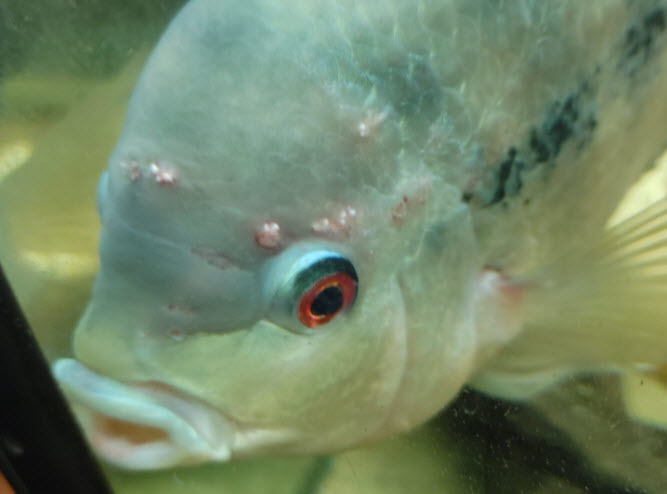
The opinions on treating a fish with antibiotics or with metro’ without clear cut evidence of the organisms being present, such as “white poop” or fin rot, is a matter of personal choice. Many experienced hobbyists, including myself, treat hole-in-the-head with with a “shotgun” food approach such as Ron’s medicated food or the food recommended in this link:
12.10. Shotgun Approach
.
For more on the many myths surrounding hole in the head one can go to this link:
11.1. Hole in the Head Syndrome

.
Return to Symptoms Menu
.
Aquarium Science Website
The chapters shown below or on the right side in maroon lead to close to 400 articles on all aspects of keeping a freshwater aquarium. These articles have NO links to profit making sites and are thus unbiased in their recommendations, unlike all the for-profit sites you will find with Google. Bookmark and browse!
.

john smith says
Thank you for this paper, this was the solution overnight all spots have gone.
I trawled the net day in day out for hours and hours how many different things it could have been no other treatment helped. i added matrix in the hang on back super cleaned the sponges in the filter till the water was clear. tank water of coarse. overnight she is nearly back to herself.
Thank you